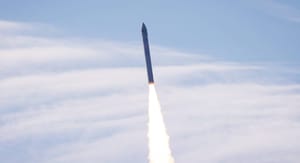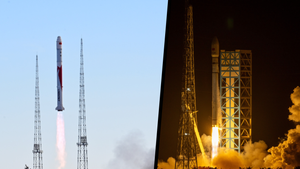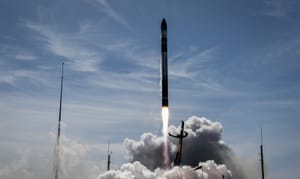
In an update on X, formerly Twitter, SpaceX announced it was targeting no earlier than the 14th of March for the third flight of its Starship-Super Heavy vehicle. This comes almost four months after the second flight test.
The vehicles that SpaceX intends to use for this flight are Ship 28 and Booster 10. Both vehicles are believed to have completed the required testing ahead of flight three. The only obstacle that needs to be overcome for the flight is regulatory approval from the Federal Aviation Administration via the issuing of an updated launch license.

The liftoff is believed to be scheduled for 12:00 pm, Universal Coordinated Time, due to SpaceX stating the start of its coverage will begin thirty minutes prior, as it is currently scheduled for 11:30 am.
SpaceX has stated the objectives for this mission are the following: successful ascent burn of both stages, opening and closing Starship’s payload door, a propellant transfer demonstration during the upper stage’s coast phase, the first ever re-light of a Raptor engine while in space, and a controlled reentry of Starship.
Starship will not be aiming to land near Hawaii, unlike the past two flights, and will aim to land in the Indian Ocean if the in-space engine startup and burn is successful.
The current schedule for Starship-Super Heavy's third flight is as follows, all times are approximate and assumes everything goes according to plan:
| 01:15:00 | SpaceX Flight Director conducts poll and verifies GO for propellant load |
| 00:53:00 | Ship LOX (liquid oxygen) load underway |
| 00:51:00 | Ship fuel (liquid methane) load underway |
| 00:42:00 | Booster LOX load underway |
| 00:41:00 | Booster fuel load underway |
| 00:19:40 | Raptor begins engine chill on booster and ship |
| 00:03:30 | Booster propellant load complete |
| 00:02:50 | Ship propellant load complete |
| 00:00:30 | SpaceX flight director verifies GO for launch |
| 00:00:10 | Flame deflector activation |
| 00:00:03 | Raptor ignition sequence begins |
| 00:00:00 | Excitement guaranteed |
After launch the nominal plan is as follows:
| 00:00:02 | Liftoff |
| 00:00:52 | Max Q (moment of peak mechanical stress on the rocket) |
| 00:02:42 | Booster MECO (most engines cut off) |
| 00:02:44 | Hot-staging (Starship Raptor ignition and stage separation) |
| 00:02:55 | Booster boostback burn startup |
| 00:03:50 | Booster boostback burn shutdown |
| 00:06:36 | Booster is transonic |
| 00:06:46 | Booster landing burn startup |
| 00:07:04 | Booster landing burn shutdown |
| 00:08:35 | Starship engine cutoff |
| 00:11:56 | Payload door open |
| 00:24:31 | Propellant transfer demo |
| 00:28:21 | Payload door close |
| 00:40:46 | Raptor in-space relight demo |
| 00:49:05 | Starship entry |
| 01:02:16 | Starship is transonic |
| 01:03:04 | Starship is subsonic |
| 01:04:39 | An exciting landing! |
What progress was made last time?
Back on the 18th of November 2023, Starship-Super Heavy made its second flight after a problematic maiden launch. The second flight was considered a successful test flight despite ending with the loss of both vehicles.
Super Heavy Booster 9 lit all thirty-three of its engines with all of them lasting up until hot staging of Ship 25 from the booster. Booster 9 however experienced a rapid unscheduled disassembly while attempting to perform its boostback burn.
After hot staging, the six Raptor engines, three sea-level engines and three vacuum engines, continued to power the second stage flight for six minutes before Ship 25 also experienced a rapid unscheduled disassembly.

SpaceX believes that the booster was lost due to a filter blockage where liquid oxygen is supplied to the engines, which led to a loss of inlet pressure in engine oxidizer turbopumps that eventually resulted in one engine failing in a way that resulted in the loss of Booster 9.
Ship 25 was believed to have been lost due to a leak in the aft section of the vehicle that started when the vehicle's liquid oxygen dump had started. This is believed to have led to fires and loss of communications which caused the onboard computers to command a shutdown of the engines, and followed shortly after by the flight termination system.
What is Starship-Super Heavy?
Starship-Super Heavy is SpaceX's in-development fully reusable super heavy-lift launch vehicle. SpaceX is currently aiming to have the launch vehicle deliver one-hundred and fifty tons to low Earth orbit while reused or two-hundred and fifty tons when expended, although there are rumors from SpaceX of an expendable payload capacity of three-hundred tons.

Starship is the second stage of the Starship-Super Heavy launch vehicle and is planned to be reused. The Starship second-stage is fifty meters tall and nine meters wide. The second-stage is powered by three sea-level Raptor engines and three vacuum Raptor Engines with plans to increase it to six in the future, these engines burn liquid methane and liquid oxygen with a maximum thrust of 1500 tons. Starship is believed to weigh one-hundred tons empty and one-thousand three-hundred tons fully fuelled. For reusability, Starship will separate from the booster, Super Heavy, in flight and continue up toward orbit. After a few orbits Starship will perform a deorbit burn and re-enter the atmosphere, after re-entry, Starship will aim to land on the chopsticks' of the launch tower, also called Mechazilla.
Super Heavy is the first-stage booster for the Starship-Super Heavy launch vehicle and is planned to be reused, it is also currently the most powerful rocket stage ever flown. The Super Heavy booster is seventy-one meters tall and nine meters wide. The booster is powered by thirty-three Raptor engines burning liquid methane and liquid oxygen with a maximum thrust of 7590 tons. Super Heavy is believed to weigh two-hundred tons empty and three-thousand six-hundred tons fully fuelled. For reusability, Super Heavy will launch from the Orbital Launch Mount and will then perform a boost back burn and land on the 'chopsticks' of the launch tower, also called Mechazilla, using its grid fins at the top for greater aerodynamic control during unpowered flight. Super Heavy also has a hot-staging ring atop of it to improve the performance of the Starship-Super Heavy stack and simplify the staging process.



